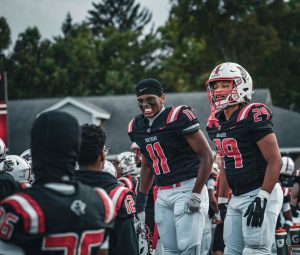MIC removes Carmel, Center Grove
Senior Theran Johnson scores a touchdown against Carmel. During the 2020 season, with the changes to the MIC it is unclear that NC and Carmel will continue to compete against each other in all sports.
January 25, 2022
After 26 years of being one of the strongest conferences in the country, the Metropolitan Interscholastic Conference is no more. On December 13, 2021 Carmel and Center Grove were unanimously voted out by the six remaining MIC schools. Rumors of them wanting to leave circulated prior, however before they could do so on their own, the six principals at the remaining schools (Ben Davis, Lawrence Central, Lawrence North, North Central, Pike and Warren Central) decided to make a preemptive removal.
In 1996, football scheduling was one of the main reasons the MIC was created. Center Grove, the largest school in the South Central Conference (Bloomington North, Bloomington South, Center Grove, Columbus North, Martinsville, Seymour and Shelbyville), was looking for a way out of their current conference. Because of trouble with scheduling football games, Warren Central and Ben Davis, also strong football programs, were seeking a new conference. The MIC was created with Ben Davis, Carmel, Center Grove, Lawrence North, North Central and Warren Central. Terre Haute North and Terre Haute South were added soon after.
Many of the bigger schools in the state: Carmel, Ben Davis, North Central and Warren Central, had to travel to Ohio, Kentucky and Northern Indiana to compete in athletic contests that give them reasonable competition.
C E Quandt, former NC principal for 17 years, was one of the founding fathers of the MIC and was in the lead position before retiring.
“It started with a discussion about athletic scheduling so we did not have to travel such long distances. We had to travel miles and miles and miles for contests and we didn’t think we should have to have that kind of a travel schedule to provide opportunities for our kids,” Quandt said.
As the schools reached out to others to join, the principals realized they wanted to create a conference for more than just athletic reasons. The “interscholastic” portion played a big role in unifying the schools.
“We incorporated leadership, performing arts and wanted our school academic leaders to come together to discuss curriculum and instruction. It started out as a scheduling issue and expanded to a broader audience that would touch all of our kids in all different aspects of school and student life,” Quandt said.
Jim Mervilde, Center Grove principal when the MIC was founded and later MSDWT superintendent, was associated with the conference for years.
“The interscholastic part of the conference, frankly, was the most obviously beneficial part for us (Center Grove) because we had everything from choir concerts to jazz band competitions to leadership programs for our teachers and students. It was just a great way for Center Grove to learn its way into the size school it was going to become,” Mervilde said.
The MIC was right up Center Grove’s alley and was where Mervilde wanted to grow the school over the next two-and-a-half decades.
“I knew we were headed in the right direction. You don’t get better unless you play or compete with people who are better. I would say the same thing academically. Academically you don’t get better working on your own stuff, you get better by learning how other programs are being run and adjusting based on that,” Mervilde said.
Mervilde was the first high school principal hired from outside of Center Grove in four years.
“When a school district hires someone from outside like my situation, they basically say there are going to be changes. When I had the opportunity to do this I eventually hired Jon Zwitt, who grew our program to be competitive, athletically, with the other schools. It never hurts to aspire for something better, rather than staying where you are,” Mervilde said.
Traveling became an issue for the Terre Haute schools, so they decided to leave the conference in 2013. This gave Lawrence Central and Pike an opportunity to join. At this point every school in the MIC was in Marion County except Carmel and Center Grove. With limited options when it comes to schools of similar sizes in the area, the conference looked outside of Indianapolis to find competition.
Many people noted how the MIC evolved into one of the best conferences in the state of Indiana and one of the most unique with all of the opportunities it provides to the students, faculty and administrators.
According to a letter distributed by the MIC principals, Carmel and Center Grove no longer wanted what the MIC had to offer, and desired another conference with different opportunities as well as wanting to “culturally align with surrounding suburban schools.”
“I interpret that (‘culturally align’) the schools want to be involved with communities that more reflect their own. Maybe socioeconomic and diversity similarities along with other aspects. It appears that Carmel and Center Grove wanted a different culture for their student body and community. Athletics seem to be what they are after and obviously don’t seem to be worried about the characteristics of the MIC, based on what they’re leaving behind,” Quandt said.
The goal for Carmel and Center Grove was to leave the MIC and join the Hoosiers Crossroads Conference. Many people were left questioning why.
Indianapolis Star high school sports reporter, Kyle Neddenriep, has covered Indiana high school sports for many years, and has contributed to addressing the situation over the past couple months.
“A lot of Carmel’s rival teams are right next to them and are in the HCC. Also, from a financial standpoint, a football game between Carmel and Westfield at Carmel would be more beneficial to Carmel,” Neddenriep said.
As Carmel and Center Grove have been state champions in multiple sports in the past, this could change the perception of the MIC being one of the most competitive conferences in the country.
“It’s unfortunate because those MIC rivalries have been so good for so long and so competitive that you wonder if those teams will even play against each other anymore.There are definitely some hard feelings and will continue to be for a while,” Neddenriep said.
The two schools leaving brings challenges to the MIC, but more specifically, North Central.
NC Athletics Director Andy Elkins is in his second year in that position.
“I want to make sure we keep the rivalries with Carmel, make sure that the programs that continue to want to play Center Grove get that opportunity if they choose to do that. What we have now is an open door of ‘no we no longer want to play either school’ and we can make that decision now, where in the past we could not do that,” Elkins said.
Football is a big part of NC and with the two schools being removed from the conference it disrupts the scheduling, giving Elkins, along with the other MIC athletic directors, another obstacle.
“We are looking to talk to Carmel and Center Grove to continue to play them at least until we can find new teams to join the conference. As of right now in 2022 we will play both schools,” Elkins said.
Carmel Athletic Director Jim Inskeep is in his 21st year in this position.
“You have to look at who is willing to play you. 6A schools like North Central and Carmel, schools are not lining up to play them, so really your list of schools that will play you is a very narrow scope and that’s why sometimes you have to expand that outside of the state as well,” Inskeep said.
There are many reasons as to why the two schools left. However, many do not know them, allowing for an abundance of assumptions to be made.
“I would never question them leaving, but they do owe people an explanation of why they left and I would hope at some point they will give one,” Mervilde said.
Carmel had their own reasons for wanting to join the HCC, without thinking they would be removed from the MIC.
“The reason for us was to provide that better competition for all of our programs across the board. Obviously we have great competition in many sports in the MIC, but we were looking for that competition piece in so many of the sports that probably do not get as much recognition and press,” Inskeep said.
Inskeep was unaware of where the “culturally aligned” phrase came from.
“I have no idea where that comment came from. It certainly did not come from us and it was not said at any meetings that I attended as a reason for looking at other schools. That is a little bit of a head scratcher for us and is unfortunate that that is a component of this situation because that is not the approach or the interest level for us with the other schools of the HCC,” Inskeep said.
On January 13, 2022 the HCC principals voted against allowing the two former MIC schools into their conference.
“Things working out the way they did, we will be competing as an independent moving forward. We’ll deal with that moving forward and make the best of it,” Inskeep said.
Carmel girls swimming, which has won 35 state titles in a row, won’t be affected because of the situation. Leaving the MIC, however, will give NC an opportunity to claim the MIC championship
NC junior girls swimmer Emily Buening has swum distance events on varsity for three years.
“I think it’ll definitely boost our team’s confidence. Not to be too cocky, but I don’t think we’ll have any trouble winning the conference in the future,” Buening said.
Numerous opportunities open up with only six members of the MIC left. Many question the schools’ decisions on wanting to leave. The future carves new paths for Carmel and Center Grove, along with everyone else affected by their decisions.












Sophia Grueninger • Jan 31, 2022 at 11:09 am
This is an amazing story! This reporter did a great job covering the content!